
From the right; Agha Poutros Elia, Agha Mirza Elia, Malik Khoshaba Malik Yousif, and next to them is a group of Russian officers, succeeded by other fighters,Surma khanem, Original Assyrian Flag – World war I,Gertrude Bell – Iraq 1909 and Calouste Gulbenkian
THE BRUSSELS LINE
HOW THE NORTH OF IRAQ GOT A BELGIAN BORDER
http://www.shlama.be
Before the First World War Ottoman Turkey dominated the entire Middle East. Turkey lost the war, its territory was split up and new states emerged. One of them was Iraq under British rule. Turkey however wanted the northern part of Iraq back and the main reason for this was the oil of Mosul. The conflict was solved in Brussels, with a Belgian diplomate who did his job, and with a remarkable oil deal to satisfy all parties. The Assyrian minority in the border region between Turkey and Iraq paid the price. Old history, indeed, and a dubious gentlemen’s agreement. From Brussels to Bush. August Thiry
New Politics
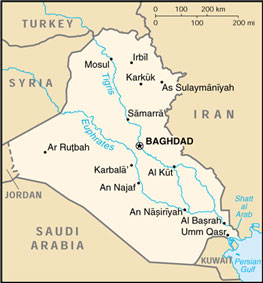
At the end of World War I British troops have conquered the greater part of Mesopotamia and reached the Mosul area. In October 1918 Great Britain and Ottoman Turkey agree on an armistice at Mudros, on the Aegean island of Lemnos. The demarcation line that separates defeated Turkey from British occupied Mesopotamia is drawn to the north of the city of Mosul
At the Paris Peace Conference the new European order is outlined according to the Fourteen Points Plan of the American president Thomas Woodrow Wilson. The Versailles Treaty of June 28, 1919, stipulates the foundation of the League of Nations, which is to interfere in future conflicts between nations. Negotiations, peaceful solutions and self-determination for peoples and minorities in the Middle East – that is truly new politics; also for the Christian Assyrians in northern Mesopotamia. They have been chased from their homeland during the war and they have become a people on the run
Assyrian Homeland
In 1915 patriarch Mar Shimun Benjamin, the spiritual and political leader of the Assyrian Christians in the mountains of Hakkari in the southeast of Turkey, sides with Great Britain, France and Russia, and declares war on the Turkish fatherland. Rev. WA Wigram, a British expert on Eastern Christianity, calls the Assyrian people Our Smallest Ally in his book with precisely that title
The Great War has just started and Turkish forces retaliate against the Assyrian traitors. The Assyrian mountaineers cannot hold their positions and the whole Assyrian population flees from Hakkari over the Turkish border to the region of Lake Urmia in Persia – nowadays the northwestern corner of Iran. There they get protection and arms from the Russians who have occupied that part of Persia
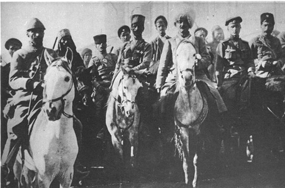
Assyrian General Agha Petros (with fur cap)
After the Russian Revolution in 1917 the Russian forces withdraw from Urmia. In March 1918 Mar Shimun Benjamin is ambushed and murdered by the Kurdish chieftain Simko, who pretended to be interested in an alliance with the Assyrians. Turkish troops are advancing towards Urmia. British officers, who are sent ahead, promise the ill-equipped Assyrians support from the British main force. Promises is all they get
In the summer of 1918 the Turks break through the Assyrian lines of defence. The Assyrians – the whole Christian people in the Salmas-Urmia region in fact – start a long and terrible exodus to the south, through the Persian mountains towards the Mesopotamian plain. After more than a month of massacres and desperate fighting against Turkish, Kurdish and Persian persecutors, eager to take revenge, the Assyrians are sheltered by the British in a large refugee camp at Baquba, to the north of Baghdad. It is a small reward for the smallest ally of the British
At the start of 1919 patriarch Mar Shimun Paulos, Benjamin’s successor, writes a letter to Colonel Wilson, Britain’s Chief Political Officer in Baghdad. The Assyrian patriarch wants to send his own representative to the Paris Peace Conference and he demands an Assyrian homeland in Mesopotamia. That autonomous Assyria under British protection should enclose the Hakkari Mountains and the districts of Mosul and Salmas-Urmia
Patriarch Paulos is young and without political experience. In fact, his influential aunt Lady Surma Khanum, pulls the Assyrian strings. In October 1919 she leaves for London to negotiate with the British government. In spite of the warm welcome she experiences, her mission comes to nothing. An autonomous Assyria is out of the question. In the districts claimed by the Assyrians the Kurds make the majority of the population and they want an independent Kurdistan for themselves in Mesopotamia
The Trouble with Mosul
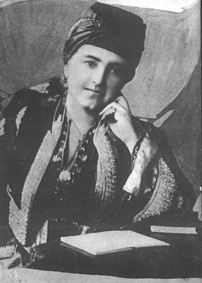
Lady Surma – Aunt of Assyrian Patriarch
The British stick to their own hidden agenda, the secret Sykes-Picot agreement with France. According to this agreement, dating from May 1916, the south of Iraq and the Syrian desert would come under British protection after the war, while the southeast of Turkey and the region of Mosul would become French protectorate. The French president Clemanceau is prepared to give up Mosul in exchange for a participation in the Mesopotamian oil
In August 1920 the Treaty of Sèvres is ratified between the allied nations that won the war and Turkey. It grants self-determination to Armenians and Kurds and demands protection in Kurdish territory for ‘the Assyro-Chaldeans and other racial and religious minorities’. The treaty also confirms the British mandate in Mesopotamia
At the start of 1921 Winston Churchill presides at the Cairo Conference. The conference decides to install Emir Faisal, the old companion of the British Colonel Lawrence of Arabia during the war, as king of the British protectorate in Mesopotamia. This new state under British mandate is called Iraq, but it takes four more years, till 1925, before it obtains its full status as a constitutional monarchy within fixed borders. The delay is caused by the conflict between the British and the Turkish Republic founded by Mustafa Kemal Atatürk. In the summer of 1922 the latter has pushed back the Greek invasion army and chased the Greek minority out of Turkey. In a winner’s mood, Atatürk also wants to incorporate the Mosul area again into the Turkish Republic. That is totally unacceptible for the British
Horse trading at Lausanne
The Lausanne Conference takes place in 1922-23. It is organized by Great Britain, France and Italy. Its general purpose is to solve the conflict between Turkey and Greece and to create the foundations for a lasting peace in the Middle East. Lausanne changes the agreements at Sèvres according to the new political reality, with the result that Armenian and Kurdish autonomy are respectively limited and completely neglected. The Conference also deals with the Mosul issue, the conflict between Great Britain and Turkey about the borderline in the north of Mesopotamia. The head of the Turkish delegation, Ismet Inönü, claims the Mosul region for Turkey. Lord Curzon, British Foreign Secretary, wants the same region to be part of the kingdom of Iraq under British mandate. The Treaty of Lausanne is ratified on July 24, 1923. Article 3 of the Treaty stipulates that the Turkish-Iraqi border will be established within the next nine months through peaceful negotiations between Turkey and Great Britain. When after that deadline no agreement has been made, the conflict will be brought before the League of Nations
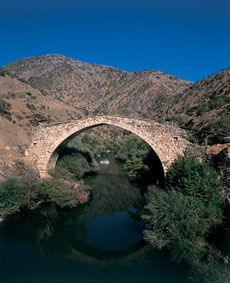
Hakkari Mountains – SE Turkey
Turkey and British Iraq negotiate in May 1924 about the Mosul issue at a meeting in Istanbul. The British play it rough. Their negotiator, Sir Percy Cox, wants Hakkari, the old Assyrian homeland in the southeast of Turkey, to be incorporated into the kingdom of Iraq. According to Cox the Assyrian minority would also get the same local autonomy that it used to have under Ottoman rule. The Turkish representative Fethi Bey rejects the whole plan and argues that the Nestorians, as he calls the Assyrians, can just as well get their old privileges back within the borders of the Turkish Republic
These negotiations come to nothing and both parties decide to appeal to the League of Nations. Meanwhile the British government keeps pleading for the annexation of the Hakkari Mountains as a part of Iraq, but it is obvious that the British use Hakkari as a means of exchange. Their real goal is the Mosul area – that is where the oil lures
Borderline Fighting
The Mosul conflict remains a hot issue. Turkey and Great Britain accuse each other of illegal actions along the demarcation line to the north of Mosul. There have been other major incidents in that area. In 1921 a Turkish army unit has occupied the small town of Rawanduz, supposedly to oppress a Kurdish rebellion there. The British from their side have brought over Assyrian warriors from the Baquba refugee camp in central Iraq to the Mosul region and they have given them military training. These Assyrian Levies, as they are called, go into action during the British campaign to relieve Rawanduz. The chaotic situation in the north of Iraq, more specific in the district of Sulaimaniyah, gets even worse when the rebellious Kurdish sheikh Mahmud Barzinji proclaims himself king of Kurdistan. In Rawanduz and during the campaign against Barzinji in Sulaimaniyah the British have to bring the RAF into action, in order to disperse the Turkish soldiers and the Kurdish irregulars with heavy air strikes

Original Assyrian Flag – World war I
On the other hand the Assyrian Levies are certainly no softies, particularly when they can take revenge on their age-old Kurdish enemies. Rev W A Wigram writes about such combats of Assyrian Levies against Kurds in his book The Assyrians and their Neighbours
‘Their (British) officers chaffed the men of one company for the roll of dead enemies that they claimed after a skirmish. Don’t tell me you got as many as that, they had said, and the Assyrians had said nothing. After the next action, however, they invited the sceptical officer to count a long row of human ears, with the grim comment: There, Sahib, you can’t say we didn’t hit those chaps
There is no change for the better in the unstable Turkish-Iraqi border region. In the autumn of 1924 the British bring Assyrian Levies into action against Turkish soldiers in Hakkari. Some Assyrian clans have returned to their old homeland in these mountains, but they have also been so bold as to assault the Turkish vali or governor of the district. Hence the Turkish punitive expedition against the Assyrian outlaws in Hakkari. During the counterattack of the Assyrian Levies from Mosul, something extraordinary must have happened, at least according to Wigram in The Assyrians and their Neighbours. The story goes as follows
A local bishop of the Assyrian Church in Hakkari, a prelate by the name of Yab Alaha, asked if he could raise Assyrian irregulars to help the British against the Turcs. Three days later he appeared with some five hundred sturdy Assyrian mountaineers. The bishop then wanted to take his force into action himself. And indeed, on the day of battle, he took off his black episcopal coat and led the attack, in purple trousers and white shirt-sleeves
Brussels Line and Mosul Commissions
Great Britain and the Turkish Republic obviously cannot come to terms. So, the League of Nations has to play its part. And now the Belgian connection enters the game. In October 1924 Belgium accepts the mandate in Ruanda-Urundi, the smaller colony east of Belgian Congo, which before the war formed part of German East Africa. The same month the Council of the League of Nations meets in Brussels. During this special meeting of the Council – its permanent seat is the Palace of Nations in Geneva, Switzerland – the delegates talk about the disputed border between Turkey and Iraq. The provisional border also gets a name, the Brussels Line, and the Council decides that a commission will be installed to investigate the situation on the spot
Mid-November 1924 the Mosul Commission is formed in Geneva. It consists of the following trio: Count Pal Teleki, former Prime Minister of Hungary; Carl Einar af Wirsén, Swedish diplomate and chairman of the Commission; and Albert Paulis, a retired Belgian colonel who was in active service in the Belgian army during the First World War. This Mosul Commission is involved in observation and investigation along the Brussels Line from January till March 1925, and in July of the same year it presents its report to the League of Nations in Geneva
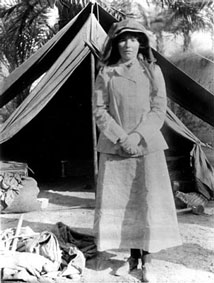
Gertrude Bell – Iraq 1909
Gertrude Bell is a British traveller. She knows the Middle East very well, she is the only female political agent in British service and she has largely contributed to the foundation of the Baghdad Archaeological Museum. Her death in 1926 in Baghdad is due to an overdose of sleeping pills. A brilliant career with an unhappy end, but what deserves our special attention here, is the letter she writes to her father on January 21, 1925. She mentions that the members of the Mosul Commission have arrived in Baghdad and that she has spent a most interesting evening with them
‘ The President is Mr de Wirsen, a Swede, honest, fat and unintelligent. The live wire is Count Teleki, a Hungarian – he is also the danger. The third is Col. Paulis, a Belgian, half way between the two others in intelligence and well meaning. After dinner, de Wirsen and Paulis began putting us questions, quite honest questions which we could answer very easily and were glad to answer (…) Mosul is the crucial point. At any rate the Commission has realized that it’s a struggle for life on the part of Iraq, not an effort on the part of the British Govt to expand its dominions. It’s Teleki I doubt. We think that he has made up his mind that whatever happens he will not offend the Turks
The League of Nations sends a second commission to the Mosul region. Its chairman is the Estonian general Johan Laidoner and Gertrude Bell has met him in Baghdad as well. In another letter she writes that Laidoner has returned from Mosul end November 1925 and is about to leave Iraq for Geneva. In his report for the League of Nations the next month, Laidoner confirms that Turkey has deported the last Assyrians of Hakkari over the Brussels Line
Both commissions come to the same conclusions. The report of the first Mosul Commission, co-authored by Albert Paulis, proposes to take the Brussels Line as the border between Iraq and the Turkish republic. It also states that Turkey should not be punished with the loss of Hakkari and that the Assyrians to some extent have to blame themselves for their exodus, while at the start of the Great War the Assyrian people has revolted against its legal government [Turkey] without reason or provocation, but incited by forces from outside [Russia]
The League of Nations reaches its final verdict. In the resolution of December 16, 1925, the Council of the League recognizes the Brussels Line as the permanent border between Iraq and Turkey. Hakkari, the lost Assyrian homeland, remains Turkish territory and the Mosul region is integrated into the north of British controlled Iraq
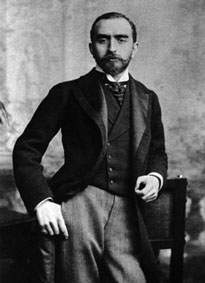
Calouste Gulbenkian
On June 5, 1926, Great Britain, Iraq and Turkey enter into a treaty about Mosul in Ankara. Turkey officially agrees to the Brussels Line as its border with the kingdom of Iraq. Article 14 of the Mosul Agreement states that Iraq will hand over ten percent of its oil-revenue to the Turkish Republic for a period of twenty-five years. Through mediation of the League of Nations the issue concerning the oil of Mosul is also settled: 52,5 percent of the shares of the Iraq Petroleum Company are for the British; French and American oil-companies get each 21,5 percent. The remaining 5 percent goes to the Armenian tycoon Calouste Gulbenkian, who has acted as a mediator for the deal. During World War II Gulbenkian flees from France to Portugal. He dies there in 1955. His fabulous art collection has been preserved, in the Museum Gulbenkian in Lissabon
Belgian Paulis
The Belgian Albert Paulis disappears from the scene, although his name is not completely erased. Much later, in the year 1964, leftist irregulars, the so-called Simba rebels, occupy the East Province of former Belgian Congo. Their stronghold is Stanleyville, now Kisangani. When the Congolese army, supported by white mercenaries, counterattacks, the Simba rebels threaten to kill their European hostages in Stanleyville. With American backup the Belgian government plans the ‘humanitarian’ action Red Dragon. The raid is executed the 24th of November 1964: Belgian paratroopers in American Hercules-aircrafts conquer Stanleyville airport and liberate the hostages
Operation Red Dragon is followed two days later by Operation Black Dragon, when Belgian paratroops cleanse the region to the northeast of Stanleyville-Kisangani. This operation takes place in and around Isiro, the major city of the district High-Uele in the Congolese East Province. Yet Isiro is a more recent name. The original one in the Belgian colonial period was Paulis. The place was named after Albert Paulis, our Belgian colonel, who after his military activities in the Great War made a second career as a successful colonial in Belgian Congo
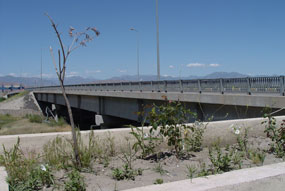
Border Turkey – Iraq – Khaburbridge on Brussels Line
In between he was engaged in international diplomacy, as a member of the first Mosul Commission. So, in 1925 one could see him strolling along the Brussels Line that separates Turkey from Iraq. It still does just that: making the border between those two countries. Paulis kept a diary about his activities in that turbulent region. It has been preserved among the official documents of the Mosul Commission in the archives of the Leage of Nations. These archives are located in the Palace of Nations in Geneva. They can be consulted on the spot by any researcher who is prepared to cope with Swiss and international bureaucracy. Some brave person should seize the opportunity sooner or later and blow the dust of decades from the Iraqi Brussels Line. Vaya con Dios
***********************************************************************************************
Notice (nala4u) ; adheres to the Assyrian naming as a nation, history,language and is not binding as a so-called Kurdistan



